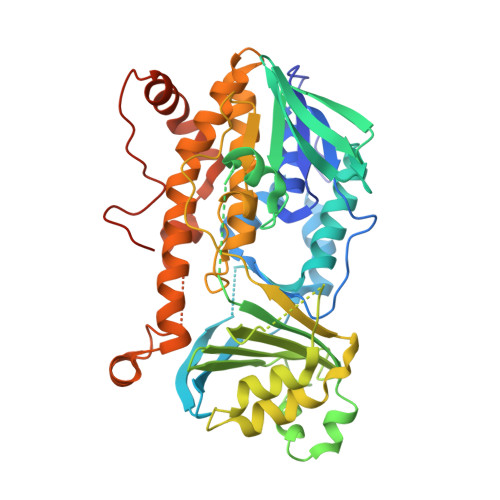Structural and Functional Analyses of a Spiro-Carbon-Forming, Highly Promiscuous Epoxidase from Fungal Natural Product Biosynthesis.
Matsushita, T., Kishimoto, S., Hara, K., Hashimoto, H., Watanabe, K.(2020) Biochemistry 59: 4787-4792
- PubMed: 33332106
- DOI: https://doi.org/10.1021/acs.biochem.0c00896
- Primary Citation of Related Structures:
7CP6, 7CP7 - PubMed Abstract:
Biosynthesis of fungal nonribosomal peptides frequently involves redox enzymes such as flavin-containing monooxygenase (FMO) to introduce complexity into the core chemical structure. One such example is the formation of spiro-carbons catalyzed by various oxidases. Because many chemically complex spiro-carbon-bearing natural products exhibit useful biological activities, understanding the mechanism of spiro-carbon biosynthesis is of great interest. We previously identified FqzB, an FMO from the fumiquinazoline biosynthetic pathway responsible for epoxidation of fumiquinazoline F that crosstalks with the fumitremorgin biosynthetic pathway to form spirotryprostatin A via epoxidation of the precursor fumitremorgin C. What makes FqzB more interesting is its relaxed substrate specificity, where it can accept a range of other substrates, including tryprostatins A and B along with its original substrate fumiquinazoline F. Here, we characterized FqzB crystallographically and examined FqzB and its site-specific mutants kinetically to understand how this promiscuous epoxidase works. Furthermore, the mutagenesis studies as well as computational docking experiments between the FqzB crystal structure and its known substrates spirotryprostatin A and B, as well as fumitremorgin C and fumiquinazoline F, provided insight into potential modes of substrate recognition and the source of broad substrate tolerance exhibited by this epoxidase. This study serves as a foundation for further characterization and engineering of this redox enzyme, which has potential utility as a valuable catalyst with broad substrate tolerance and an ability to introduce chemical complexity into carbon frameworks for chemoenzymatic and biosynthetic applications.
Organizational Affiliation:
Department of Pharmaceutical Sciences, University of Shizuoka, Shizuoka 422-8526, Japan.

















